This post may contain affiliate links. Please read our disclosure policy.
Cook tender, flaky, restaurant-quality baked teriyaki salmon in just 15 minutes with a sticky sweet homemade teriyaki sauce, sesame seeds, and green onions! A quick, simple, low-carb main!
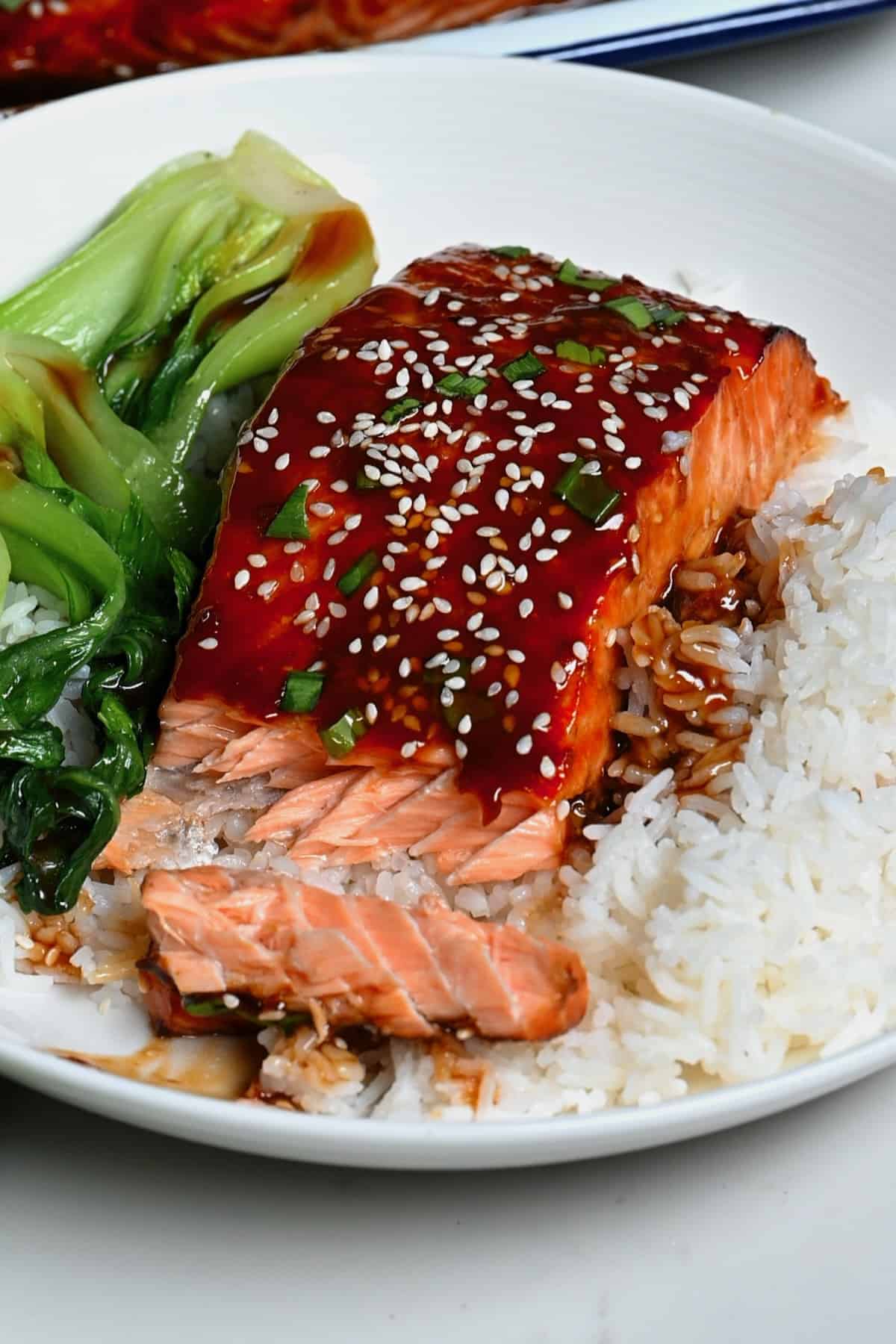
This recipe combines perfectly juicy, tender, flaky salmon marinated and served with a savory-sweet homemade teriyaki glaze. This baked teriyaki salmon is a quick, simple, practically fool-proof protein. All it requires is a few minutes of hands-on prep and 20 minutes of hands-off marinating. Then 15 minutes of baking and enjoy at lunch or dinner with rice, quinoa, noodles, or green veg for a low-fuss meal!
By using a homemade teriyaki sauce recipe, you can avoid an excess of sugar, sodium, and preservatives in store-bought versions for superior nutrition and flavor. Not to mention it’s naturally gluten-free and easily tweakable to your flavor preferences. Plus, both the sauce and prepared teriyaki glazed salmon are make-ahead and freezer friendly for a delicious meal prep meal!
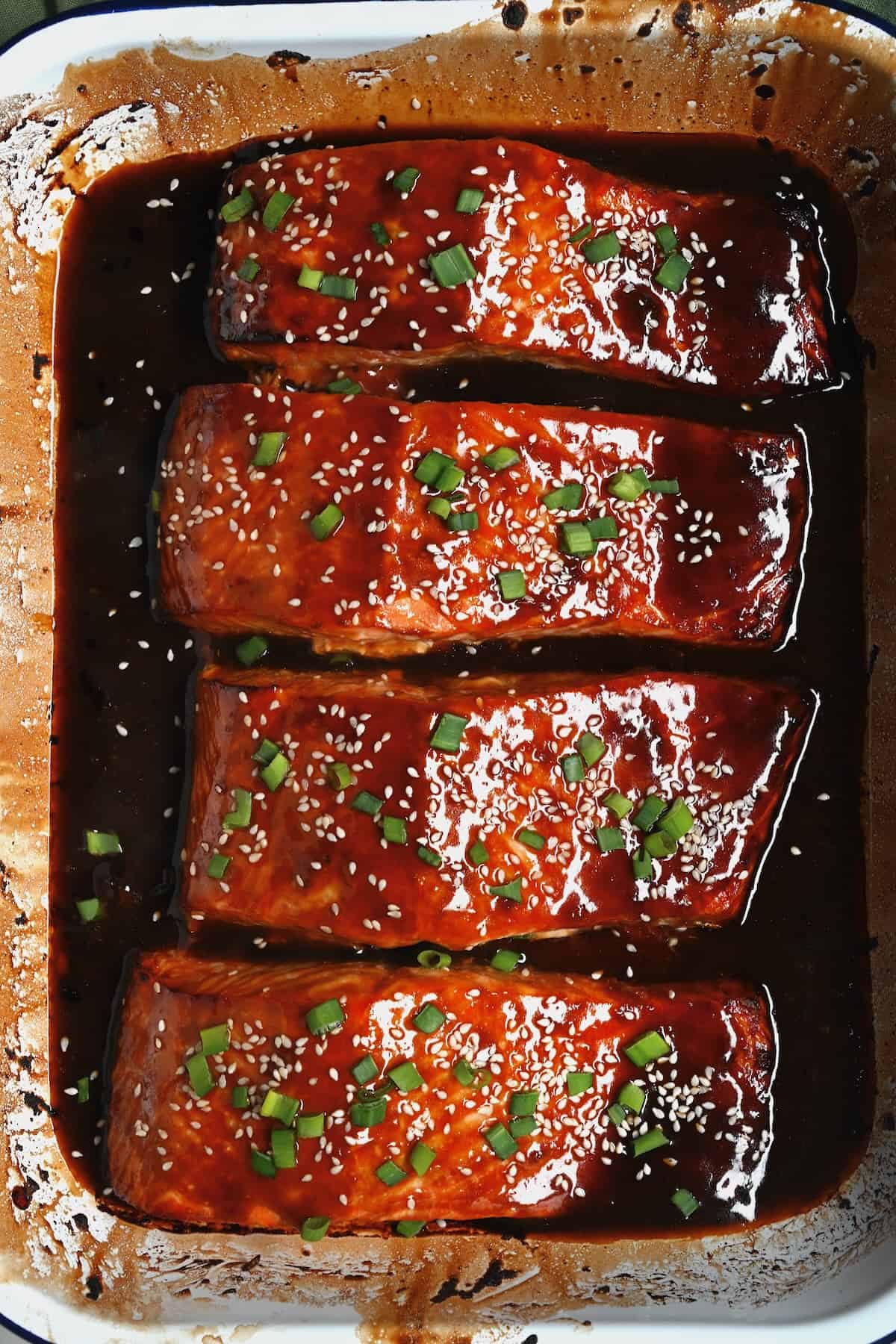
Want to save this recipe?
Watch how I make it
Teriyaki salmon ingredients
- Salmon fillets: Use fresh or frozen (fully thawed) salmon fillets. It’s best to use fillets similar in thickness/size, so they cook evenly. I prefer to use skin-on, bones removed, pre-filleted wild sockeye/king salmon. However, you can use one large piece and cut it into fillets yourself.
- Garnish: I use sesame seeds and thinly sliced green onions (scallions).
Wild vs. farmed salmon? Wild salmon is usually leaner, lower in calories and fat, and higher in minerals and long-chain omega-3 fatty acids. It’s also overall better tasting than farmed salmon.
Teriyaki sauce
- Sweetener: I use a combination of honey (or maple syrup) and brown sugar for the most delicious flavor. Though you could omit the brown sugar and/or adjust the amounts to your preference.
- Soy sauce: Use reduced-sodium soy sauce if preferred. Use tamari or coconut aminos if gluten-free.
- Toasted sesame oil: For toasty depth.
- Mirin: Mirin is a sweet and tangy Japanese rice wine available in most supermarkets/Asian stores. Alternatively, use rice vinegar or white wine vinegar.
- Aromatics: This sauce relies on both ginger and garlic. Fresh is best, but ginger and garlic puree/paste will work in a pinch.
- Cornstarch: This will help thicken the marinade into a sticky teriyaki glaze.
- Water: To bring the marinade to the correct consistency. For more flavor, use orange juice or pineapple juice.
Optionally add some heat with red pepper flakes or sriracha sauce.
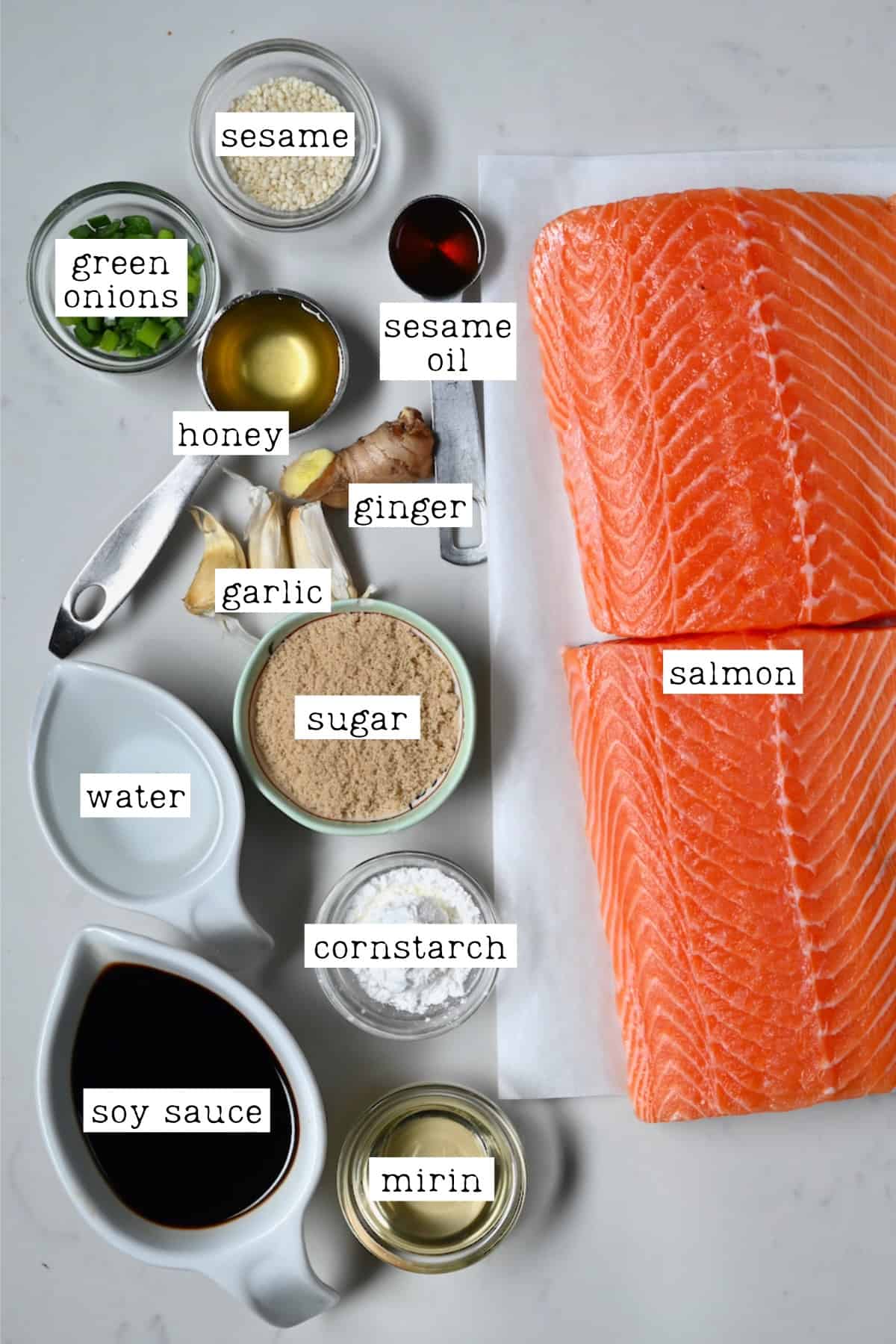
How to make teriyaki salmon in the oven
Preparing this oven baked teriyaki salmon recipe is surprisingly simple and requires just a few steps.
First, mince/grate the ginger and garlic and whisk all the sauce ingredients (except the cornstarch) in a large bowl.
If needed, cut the salmon into fillets.
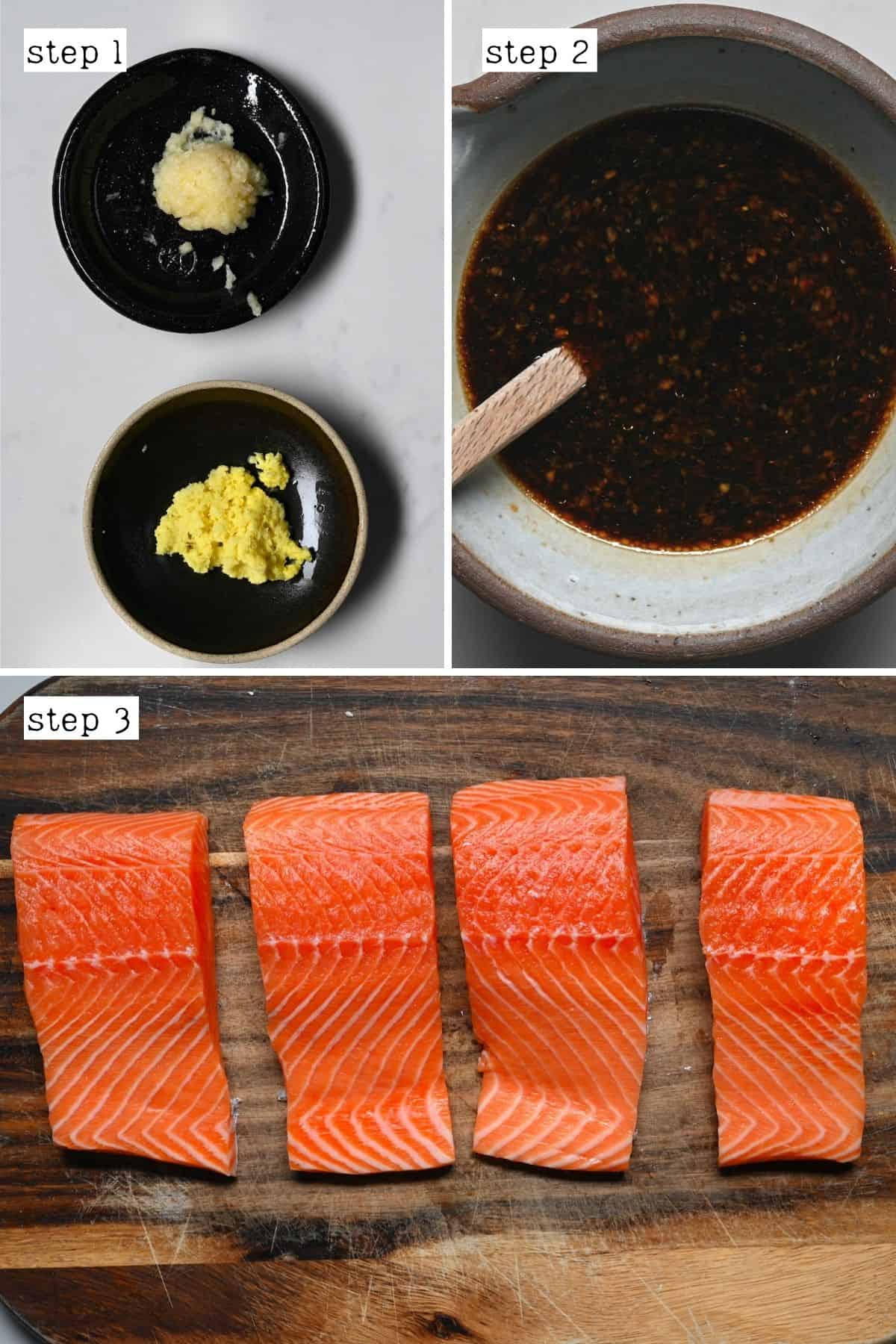
Next, transfer the salmon fillets to a high-sided baking dish (or bowl). Pour the teriyaki salmon marinade over it and cover it with plastic wrap.
Leave them to marinate for 20-30 minutes (transfer to the fridge if leaving for longer – up to 12 hours). Preheat the oven to 400ºF/200ºC in the last 10-15 minutes.
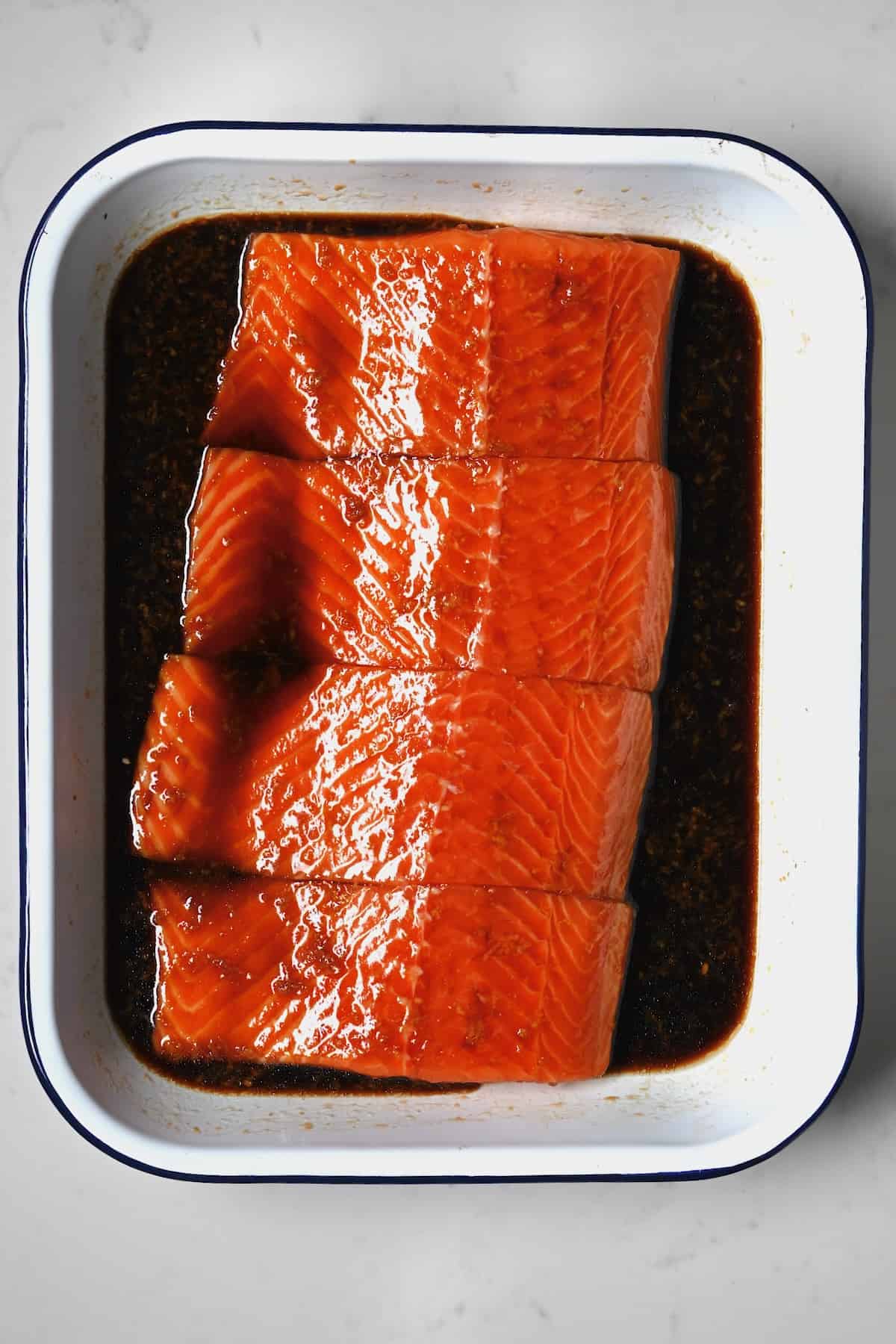
Next, pour the excess marinade into a small saucepan. Lightly grease the baking dish or transfer the salmon skin side down to a parchment/foil-lined baking sheet.
How long to bake teriyaki salmon
Bake the salmon in the center of the oven for 13-15 minutes or until cooked through and flaky.
The cooking time will vary based on the thickness of the fillets and the type of salmon used. Note that farmed salmon is fattier and requires longer to cook. It also depends on your individual oven and preference.
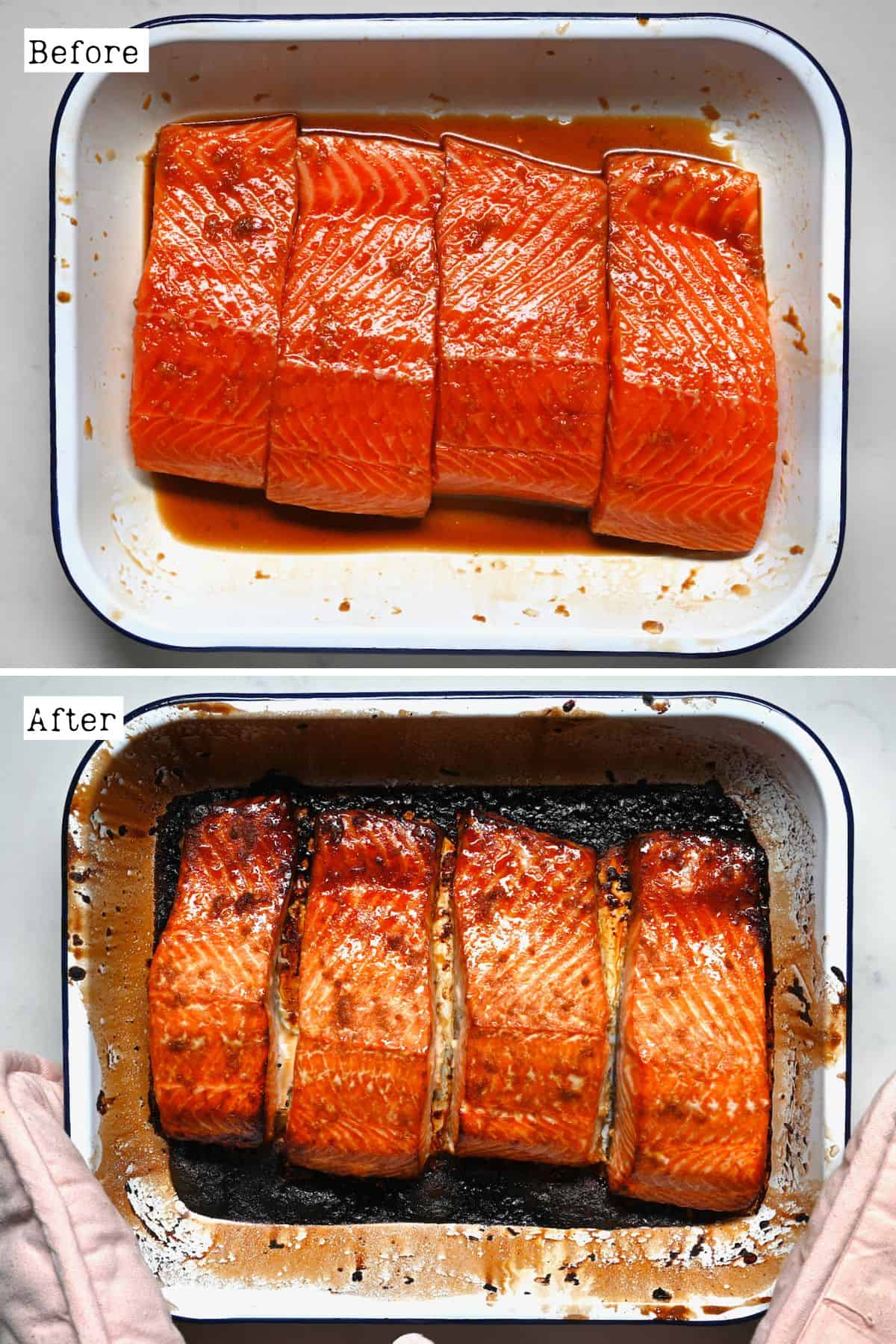
How to tell the salmon Is done? Lightly press the top of a salmon filet with your finger. If it separates into flakes, it’s ready. Alternatively, an instant-read thermometer inserted into the thickest part should read 125-140ºF/51-60ºC.
Preparing the teriyaki sauce for salmon
While the salmon cooks, prepare the teriyaki glaze. Combine the cornstarch with 2 Tbsp water in a small bowl, then add it to the saucepan with the marinade.
Bring the mixture to a boil, then immediately lower it to a simmer (medium heat). Cook, constantly stirring, until thickened.
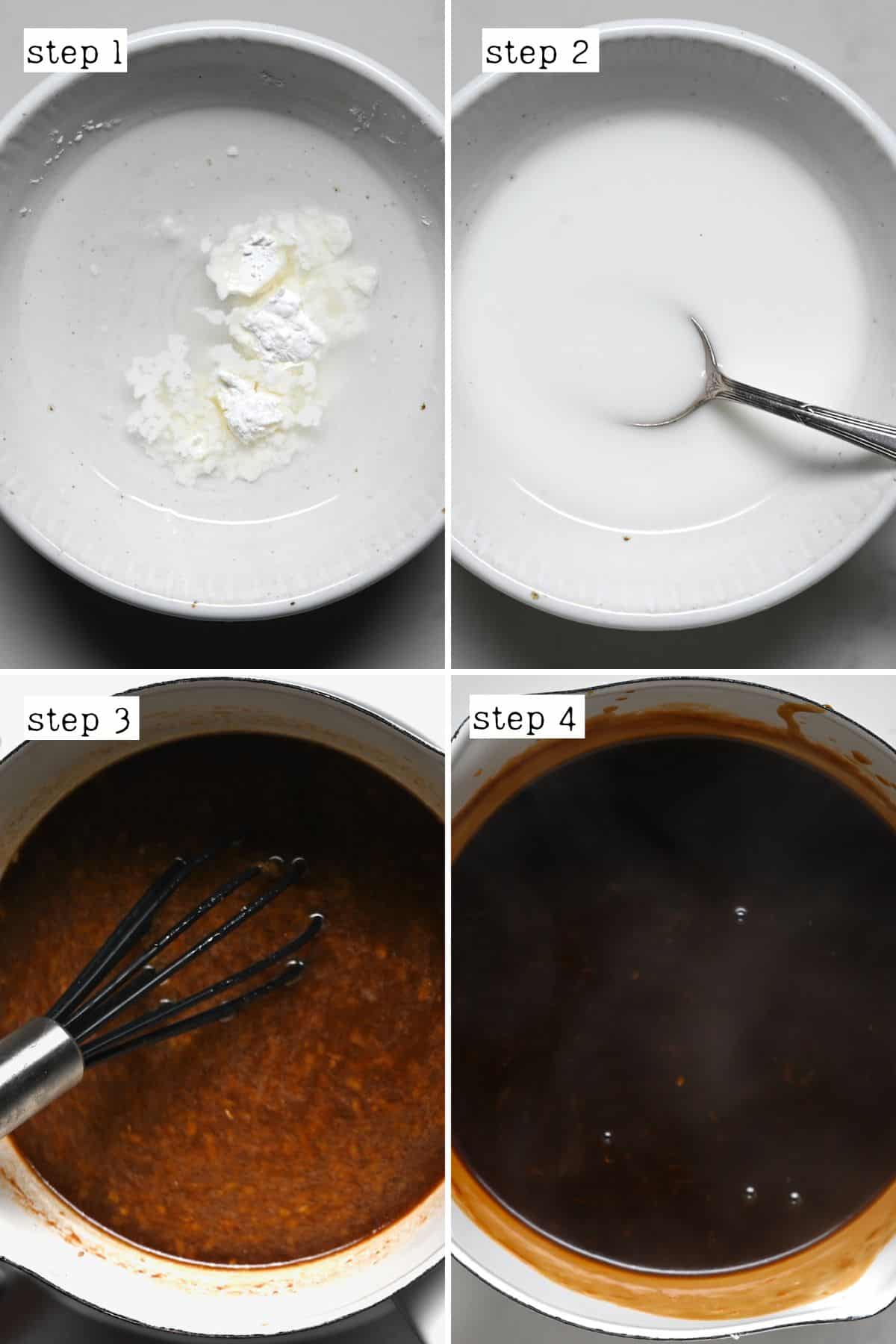
When the salmon is cooked, serve it with the teriyaki sauce. Optionally, sprinkle it with sesame seeds and thinly sliced green onions. Enjoy!
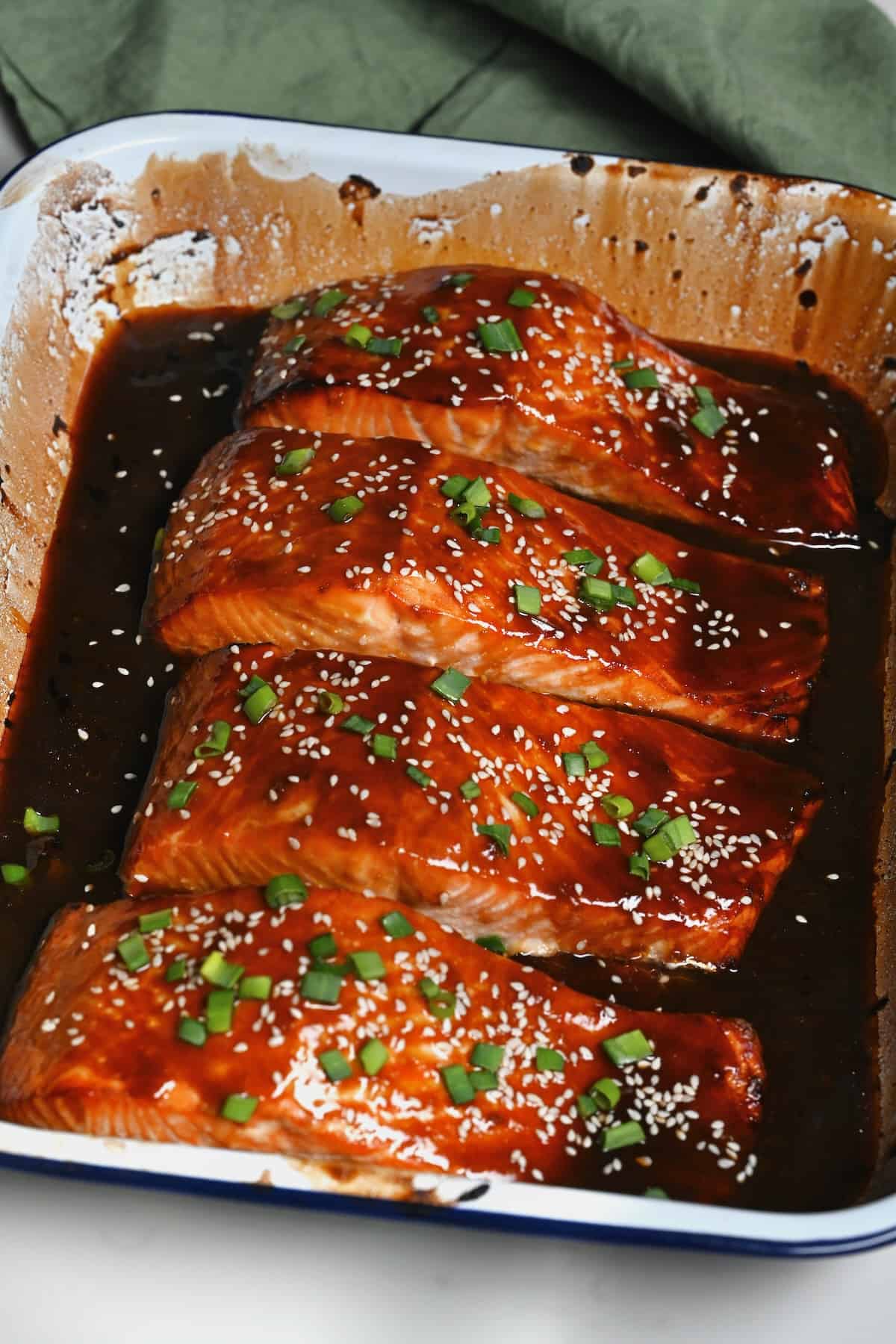
What to serve with teriyaki salmon
This teriyaki fish dish is versatile and pairs well with:
- Grains: brown rice, Jasmine rice, quinoa, pilaf, etc. Or low-carb cauliflower rice.
- Cooked vegetables: Like bok choy, oven roasted asparagus, sauteed broccoli, roasted Brussels sprouts, roasted green beans, roasted artichoke, easy snow peas, corn on the cob, etc.
- Potatoes: Roasted, baked, or mashed potatoes (or mashed sweet potato).
- Noodles: Create super simple and delicious teriyaki salmon noodles or a noodle stir-fry dish combining noodles and vegetables.
- Teriyaki salmon bowls: Serve over a bed of grains. Add mixed green veggies, pickled carrots, avocado slices, and a drizzle of sriracha mayo.
You can use leftover salmon to make teriyaki salmon burgers, add to salads, tacos, wraps, etc.
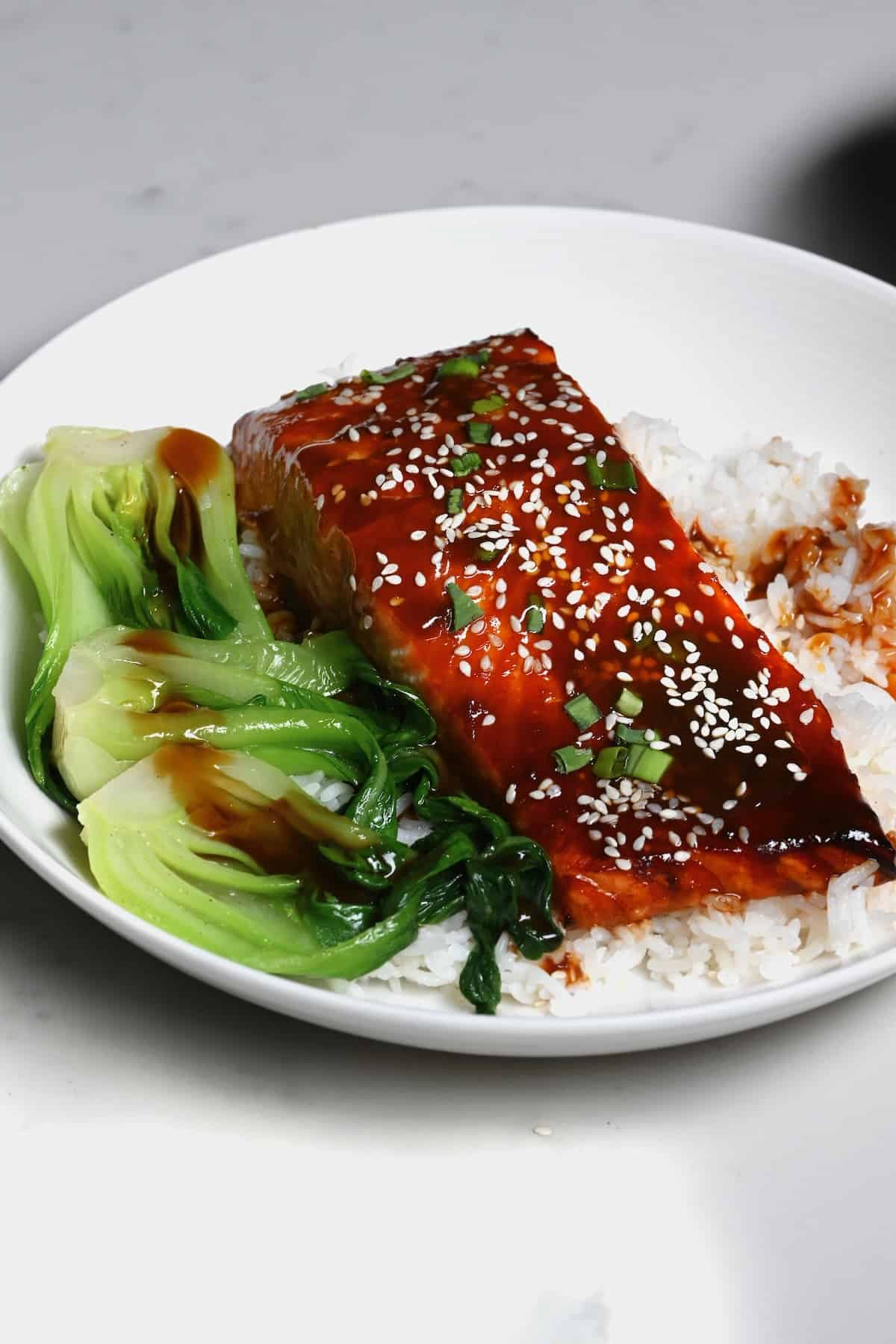
More salmon recipes
If you try this glazed teriyaki salmon, let me know how it goes in the comments below. I’d appreciate a recipe card rating and would love to see your recipe recreations – tag me on Instagram @Alphafoodie!
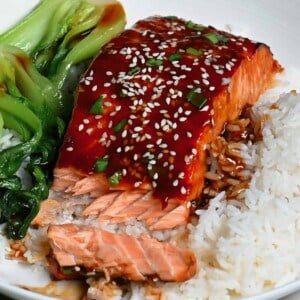
Easy Baked Teriyaki Salmon
Ingredients
- 2 lb salmon 4 fresh or frozen (thawed) fillets
Teriyaki Sauce
- 1/2 cup soy sauce low sodium if preferred; or tamari/coconut aminos if gluten-free
- 1 oz light brown sugar 1/4 cup – or more honey
- 1 Tbsp honey or maple syrup
- 1/2 Tbsp grated ginger or 1/2 teaspoon ground ginger
- 0.3 oz garlic 2 large cloves
- 1/2 Tbsp sesame oil
- 3 Tbsp mirin or rice vinegar
- 1/2 cup water or orange/ pineapple juice
- 1 Tbsp cornstarch to thicken it to a glaze
To garnish
- 1/2 Tbsp sesame seeds optional
- 1-2 stalks green onions optional
Instructions
- Mince/grate the ginger and garlic and whisk all the sauce ingredients (except the cornstarch) in a large bowl. If needed, cut the salmon into fillets.
- Transfer the salmon fillets to a high-sided baking dish (or bowl), pour the marinade over, and cover them with plastic wrap. Leave them to marinate for 20-30 minutes (transfer to the fridge if leaving for longer- up to 12 hours). Preheat the oven to 400ºF/200ºC in the last 10-15 minutes.
- Pour all the excess marinade into a small saucepan. Lightly grease the dish beneath the salmon or transfer it skin side down to a parchment/foil-lined baking sheet.
- Bake the salmon in the center of the oven at 400ºF/200ºC for 13-15 minutes or until cooked through and flaky.To tell if it's ready: Lightly press the top of a salmon filet with your finger. If it separates into flakes, it’s ready. Alternatively, an instant-read thermometer inserted into the thickest part of the fillet should read 125-140ºF/51-60ºC.
- While the salmon cooks, combine the cornstarch with 2 Tbsp water in a small bowl until smooth, then add it to the saucepan with the marinade.
- Bring the mixture to a boil, then immediately lower it to a simmer (medium heat) and cook, constantly stirring, until thickened.
- When the salmon is cooked, serve it with the teriyaki glaze, and sprinkle it with sesame seeds and thinly sliced green onions. Enjoy!
How to Make Ahead and Store
- Make ahead: the sauce will store for 3-5 days. You could also leave the salmon in the marinade for up to 12 hours in the refrigerator. Remove from fridge 15-20 minutes before cooking.Store: Store cooled leftovers in an airtight container in the refrigerator for up to five days.Freeze: Allow it to cool before transferring it to a ziplock bag (squeezing out excess air) and freezing it for up to one month. Thaw in the refrigerator before eating chilled or reheating.Reheat: My preferred method for reheating the fish is with a microwave or a nonstick skillet on the stovetop. Add a splash of water, place it skin side down, cover, and cook over low heat until heated.
Video
Notes
- For the salmon: I prefer skin-on, bones removed, wild sockeye/king salmon either pre-filleted or to cut into fillets myself. Also, use room-temperature salmon. This ensures even baking (along with using fillets with a similar thickness).
- Cook salmon with skin: This helps keep the fish from drying out and holds it together while baking/moving around.
- Create a sheet pan meal: Use veggies that bake at a similar time (bell peppers, green beans, broccoli, etc.) and toss with a little oil, salt, and pepper.
- Tweak flavors: It’s easy to adjust the ingredient ratio to make the best teriyaki sauce for salmon for your taste buds.
- Using leftover teriyaki sauce: It works well with other proteins, too. I.e., teriyaki chicken, shrimp, beef, tofu, etc.
Nutrition
Nutrition information is automatically calculated, so should only be used as an approximation.

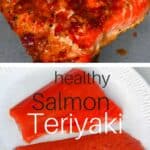


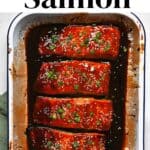
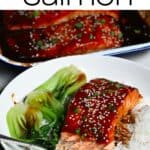

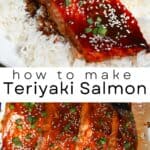
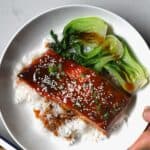









Delicious, salmon was perfect and I added cherry tomatoes asparagus green beans and baby spinach to the dish.
Yummo!
Thanks for your comment, Andrea. Glad you liked it!
I can not wait to make this recipe
LOOKS AWESOME
Thank You
I hope you like it! 🙂